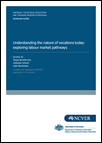Description
Focusing on four vocational streams – financial services, primary industry, healthcare/community services and trades/engineering – this paper is an initial exploration of pathways into the labour market and how people actually use these pathways. It uses Household, Income and Labour Dynamics in Australia data to explore common patterns of labour market activity and education engagement, as well as identifying the overarching career trajectories associated with these patterns. This work is part of the three-year research program, 'Vocations: the link between post compulsory education and the labour market'.
Summary
About the research
This paper is part of a wider three-year program of research, 'Vocations: the link between postcompulsory education and the labour market', which is investigating both the educational and occupational paths that people take and how their study relates to their work.
This paper uses data from the Household, Income and Labour Dynamics in Australia (HILDA) Survey to initially explore the movements individuals take through the labour market. The authors use the notion of 'vocation' — occupations with an underlying similarity of practice — as the basis of their analysis. An example of a 'vocation' is care work, which encompasses occupations such as nursing, aged care and childcare.
The paper focuses on four areas: financial services, primary industry, community services and healthcare, and trades and engineering.
Key messages
- Most workers spend long periods of time in one occupation. The authors call this occupational stasis, and it is particularly evident in the health sector.
-
Labour market movements tend to follow three pathways:
-
High trajectory pathways, which show upward movement through occupations and which are experienced more by those in professional roles. More defined occupational labour markets
(that is, those that require registration) also have greater upward mobility - Low trajectory pathways, which are characterised by high turnover and little movement into higher skilled roles. They are experienced more by sales workers and labourers
- Pathways of marginal attachment, which include periods in unemployment or not in the labour force. These pathways are experienced more by women moving in and out of the labour force, as well as by some older workers.
-
High trajectory pathways, which show upward movement through occupations and which are experienced more by those in professional roles. More defined occupational labour markets
- There are entrenched social and labour market settings (that is, labour market segmentation), which make movement from low-skilled occupations to high-skilled occupations a rarity, even within a single vocational stream.
Tom Karmel
Managing Director, NCVER
Download
Related items
This discussion paper introduces the overarching concepts for the three-year research program, 'Voca… Show more
As part of the three-year research program, 'Vocations: the link between post compulsory education a… Show more
This working paper is an initial examination of what is known about pathways in tertiary education,… Show more
This report explores the transitions students make in undertaking a second qualification (i.e. wheth… Show more
This report explores the movements that workers make in the workforce and whether there are any comm… Show more
